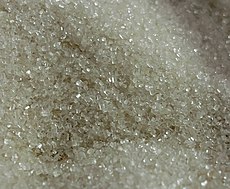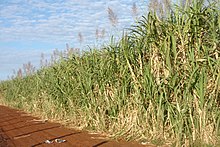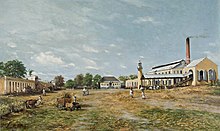चीनी

चीनी (अंग्रेजी: शुगर; हिंदी: शक्कर, शर्करा) सवाद में मीठ लागे वाला, पानी में घुल सके वाला कार्बोहाइड्रेड होला, आ खाना में अउरी बिबिध खाए वाली चीज बनावे में इस्तमाल होला। ई कई अलग-अलग चीज से बनल हो सके ला जइसे कि भारत में गन्ना के रस से चीनी बनावल जाला जबकि कई देस सभ में ई चीनी चुकंदर भा गंजी से भी बनावल जाला।
सिंपल चीनी, जेकरा के मोनोसैक्राइड कहल जाला, तीन परकार के होलीं - ग्लूकोज, फ्रक्टोज आ गैलाक्टोज। आमतौर पर जवना दानेदार या रवा (क्रिस्टल) वाली चीनी के हमहन देखीं ला जा ऊ चीनी के एक ठो प्रकार भर हवे। एकरा के अंग्रेजी में "टेबल शुगर" कहल जाला। ई ग्लूकोज आ फ्रक्टोज के मिलजुल रूप होला आ तकनीकी भाषा में सुक्रोज कहाला; रासायनिक रूप में एही के डाईसैक्राइड कहल जाला। एह चीनी के इस्तेमाल कई किसिम के खाना में भा मिठाई में होला या फिर रसोईघर में ई इस्तेमाल होला चाय काफी बनावे में सीधे चम्मच से डाल के घोर दिहल जाला। शरीर में जा के एह सुक्रोज के हाड्रोलाइज होखे, मने कि पानी में घुल के टूट जाए पर ग्लूकोज आ फ्रक्टोज अलगा हो जालें। अइसन अउरी डाईसैक्राइड सभ में माल्टोज आवे ला जे अनाज में मौजूद चीनी होला आ लैक्टोज आवे ला जे दूध में मौजूद चीनी होला। चीनी के, रासायनिक रूप से अउरी लमहर लड़ी सभ के ओलिगोसैक्राइड भा पॉलीसैक्राइड कहल जाला। कुछ अन्य चीज, जइसे कि ग्लिसेरोल भा शुगरएल्कोहल के सवाद भी मीठ जरूर होला बाकी इनहन के चीनी के अंतर्गत ना रखल जाला। डायटिंग वाला खाना में मिठास खातिर इस्तेमाल होखे वाली चीज में एस्परटेम आ सुक्रालोज के इस्तेमाल होला जे सुक्रोज के क्लोरीनेटेड रूप होखे लें।
चीनी के कुछ न कुछ मात्रा ज्यादातर पौधा सभ के टिशू में मिले ला आ गन्ना आ चीनी चुकंदर (सुगरबीट) के पौधा सभ में एकर मात्रा अतना होला कि आसानी से बानिज्यिक रूप से निकाल के बिलग कइल जा सके ला। साल 2017–18 में, पूरा दुनियाँ में चीनी के कुल उत्पादन 185 मिलियन टन रहल। पूरा दुनियाँ में, औसतन 24 किलोग्राम (850 औंस) चीनी प्रति ब्यक्ति सालाना खपत होला (33.1 किग्रा बिकसित देस सभ में), जे लगभग 260 खाना कैलोरी प्रति ब्यक्ति प्रति दिन के बरोबर होला। बीसवीं सदी के अंतिम दौर के बाद से ई सवाल प्रमुख रूप से सोझा रखल गइल बा कि का अतना बेसी मात्रा में चीनी के खाइल, खासतौर पर रिफाइंड चीनी (साफ कइल आ ब्लीच क के उज्जर बनावल) के खाइल, मनुष्य के सेहत खाती ठिक बा कि ना। बेसी मात्रा में चीनी के खाए के कारन मोटापा, शुगर, कार्डियोवेस्कुलर बेमारी (दिल आ खून के नस संबंधी), डिमेंशिया आ दाँत के क्षय होखले के संभावना के साथे जोड़ल गइल बा। एह तरह के कई गो अध्ययन भइल बाड़े, हालाँकि मुख्य रूप से पर्याप्त आँकड़ा के अभाव में रिजल्ट सभ अलग-अलग किसिम के रहल बाड़ें।
नाँव
[संपादन करीं]भोजपुरी में चीनी भा चिन्नी, एकदम उज्जर दानेदार चीनी के कहल जाला। एकर उत्पत्ती चीन देस के ऊपर भइल बतावल जाला। हालाँकि गन्ना के रस से रवादार गुड़ आ ढोंकादार खंड बनावे के बिधि भारत में खोजल गइल आ इहाँ से बाकी जगह चहुँपल, एकरा के साफ क के उज्जर रंग देवे के खोज फारस में आ मिस्र में भइल अइसन मानल जाला (जवना से मिस्री भा मिसरी शब्द के उत्पत्ती बतावल जाला) आ चीन एगो समय में अइसन उज्जर चीनी के बड़हन उत्पादक बनल जहाँ से ई शब्द भारत में चलन में आ गइल।[1][2] हालाँकि, ज्यादातर लोग एह शब्द के उत्पत्ती चीन देस के साथे जोड़े ला,[3] कुछ लोग एकरा के फारसी शब्द शीरनी से भी जोड़े ला जे मध्यकाल में सत्यपीर (सत्यनारायण भगवान) के परसाद में चढ़ावल जाय।[4]
संस्कृत में चीनी के शर्करा कहल जाला। इतिहासी रूप से एकर उत्पत्ती भारत में भइल आ इहाँ से ई बाकी जगह चहुँपल जेकर परभाव शब्द पर भी देखाई देला आ बिबिध भाषा में एकर नाँव शर्करा से निकसल बतावल जालें। फारस में शर्करा के शक्कर भा शकर बनल, उहाँ से ई अरबी में शक्कर के रूप में गइल आ मध्यकालीन लैटिन भाषा में सुक्कारम, आ बारहवीं सदी के पुरानी फ्रेंच भाषा में सुक्रे, आ इहाँ से अंग्रेजी भाषा में शुगर बनल।[5] इटैलियन में जुचेरो, स्पैनिश में अजुकार, आ पुर्तगाली में असुकार सीधे अरबी से आइल हवे, स्पेनिश आ पुर्तगाली में मूल अरबी डेफिनिट आर्टिकल (अंग्रेजी वाल ए/ऍन नियर अल के अ) बचल रह गइल।[5] सभसे पुरान प्रमाणित यूनानी शब्द σάκχαρις (सक्काःरिस) बतावल जाला।
अंग्रेजी के शब्द जैजरी, जवन गुड़ खाती भा खजूर से बनल भूअर चीनी खातिर इस्तमाल होला, एही तरह से पुर्तगाली के जागरा से आइल हवे जे खुद मलयालम के ചക്കരാ (सक्कर), आ मूल संस्कृत शर्करा से आइल हऽ।[6]
इतिहास
[संपादन करीं]प्राचीन काल आ मध्यजुग
[संपादन करीं]
भारतीय उपमहादीप में[7] प्राचीन काल से चीनी के उत्पादन कइल जात रहल बा आ इहँवा से ई आज के जमाना के अफगानिस्तान में चहुँपल, खैबर दर्रा से हो के।[8] सुरुआती दौर में ई बहुत भारी मात्रा में ना उपराजल जाय आ बहुत सस्ता भी ना रहे, मिठास खातिर आमतौर पर मधु (शहद) के इस्तेमाल दुनिया के ज्यादातर हिस्सा में होखे। मूल रूप से लोग ऊख के सीधे चबा के चूभे आ एकर मिठास लेवे। ऊख मूल रूप से उष्णकटिबंधी दक्खिन एशिया आ दक्खिन पुरुब एशिया के पौधा रहबो कइल।[9] एकर अलगा-अलगा प्रजाति सभ अलगा-अलगा लोकेशन पर पैदा भइल जइसे कि सैकारम बारबेरी के मूल भारत हवे आ सैकारम एडुले आ सैकारम ओफिसिनारम न्यू गिनी के मूल के हवें।[9][10] चीन के हाथ से लिखल पोथी सभ में ऊख के सभसे पुरान उल्लेख 8वीं-सदी ईसा पूर्ब के बा जे एकर उतपत्ती भारत में बतावे ला।[11]
परंपरागत भारतीय बैदकी (आयुर्वेद) में, ऊख के इक्षु आ एकरे रस के फाणित के नाँव से उल्लेख मिले ला। एकर प्रकार, पर्यावाची आ लच्छन सभ निघंटु में बर्णित बाड़ें, जइसे कि "भावप्रकाश" (1.6.23, ऊख के बिबिध प्रकार) के बिबरन मिले ला।[12]
यूरोप में ऊख के मिले के परमान 1ली-सदी ईस्वी में मिले ला, बाकी ई खाए वाली चीज के रूप में ना बलुक आयात कइल दवाई के रूप में इस्तमाल होखे।[13][14] यूनानी बैद पेडानियस डायोस्कोराइडेस अपना पहिली सदी ईस्वी के बैदकी के किताब दे मटेरिया मेडिका में ऊख के गुण के बिबरन देले बाड़ें,[15] आ प्लिनी (बड़का) जे एगो पहिली सदी ईस्वी के रोमन बिद्वान रहलें, अपना "नैचुरल हिस्ट्री" नाँव के इतिहासी किताब में एकर बिबरन देले बाड़े: "चीनी अरब में भी बने ले, बाकी भारतीय चीनी बेहतर होला। ई एक किसिम के मधु हवे जे ऊख में होला. गोंद नियर सुफेद होला, आ दांत के बिचा में कुरकुरा होखे ला। ई पहाड़ी बदाम (हेज़लनट) के बरोबर ढोंक में आवे ला। ई खाली दवाई खातिर इस्तमाल कइल जाला।"[14]
Sugar remained relatively unimportant until the Indians discovered methods of turning sugarcane juice into granulated crystals that were easier to store and to transport.[16] Crystallized sugar was discovered by the time of the Imperial Guptas, around the 5th century CE.[16] In the local Indian language, these crystals were called khanda (Devanagari: खण्ड, Khaṇḍa), which is the source of the word candy.[17] Indian sailors, who carried clarified butter and sugar as supplies, introduced knowledge of sugar on the various trade routes they travelled.[16] Buddhist monks, as they travelled around, brought sugar crystallization methods to China.[18] During the reign of Harsha (r. 606–647) in North India, Indian envoys in Tang China taught methods of cultivating sugarcane after Emperor Taizong of Tang (r. 626–649) made known his interest in sugar. China then established its first sugarcane plantations in the seventh century.[19] Chinese documents confirm at least two missions to India, initiated in 647 CE, to obtain technology for sugar refining.[20] In South Asia, the Middle East and China, sugar became a staple of cooking and desserts.
Crusaders brought sugar home with them to Europe after their campaigns in the Holy Land, where they encountered caravans carrying "sweet salt". Early in the 12th century, Venice acquired some villages near Tyre and set up estates to produce sugar for export to Europe, where it supplemented honey, which had previously been the only available sweetener.[21] Crusade chronicler William of Tyre, writing in the late 12th century, described sugar as "very necessary for the use and health of mankind".[22] In the 15th century, Venice was the chief sugar refining and distribution centre in Europe.[11]
आधुनिक इतिहास
[संपादन करीं]
In August 1492, Christopher Columbus stopped at La Gomera in the Canary Islands, for wine and water, intending to stay only four days. He became romantically involved with the governor of the island, Beatriz de Bobadilla y Ossorio, and stayed a month. When he finally sailed, she gave him cuttings of sugarcane, which became the first to reach the New World.[23] The first sugar cane harvest was conducted in Hispaniola in 1501, and many sugar mills had been constructed in Cuba and Jamaica by the 1520s.[24] The Portuguese took sugar cane to Brazil. By 1540, there were 800 cane sugar mills in Santa Catarina Island and another 2,000 on the north coast of Brazil, Demarara, and Surinam.

Sugar was a luxury in Europe until the 18th century, when it became more widely available. It then became popular and by the 19th century, sugar came to be considered a necessity. This evolution of taste and demand for sugar as an essential food ingredient unleashed major economic and social changes.[25] It drove, in part, colonization of tropical islands and nations where labor-intensive sugarcane plantations and sugar manufacturing could thrive. The demand for cheap labor to perform the hard work involved in its cultivation and processing increased the demand for the slave trade from Africa (in particular West Africa). After slavery was abolished, there was high demand for indentured laborers from South Asia (in particular India).[26][27][28] Millions of slave and indentured laborers were brought into the Caribbean and the Americas, Indian Ocean colonies, southeast Asia, Pacific Islands, and East Africa and Natal. The modern ethnic mix of many nations that have been settled in the last two centuries has been influenced by the demand for sugar.[29][30][31]

Sugar also led to some industrialization of areas where sugar cane was grown. For example, Lieutenant J. Paterson, of the Bengal establishment, persuaded the British Government that sugar cane could be cultivated in British India with many advantages and at less expense than in the West Indies; as a result, sugar factories were established in Bihar in eastern India.[32] During the Napoleonic Wars, sugar beet production increased in continental Europe because of the difficulty of importing sugar when shipping was subject to blockade. By 1880, the sugar beet was the main source of sugar in Europe. It was cultivated in Lincolnshire and other parts of England, although the United Kingdom continued to import the main part of its sugar from its colonies.[33]
Until the late nineteenth century, sugar was purchased in loaves, which had to be cut using implements called sugar nips.[34] In later years, granulated sugar was more usually sold in bags. Sugar cubes were produced in the nineteenth century. The first inventor of a process to make sugar in cube form was the Moravian Jakub Kryštof Rad, director of a sugar company in Dačice. He began sugar cube production after being granted a five-year patent for the process on January 23, 1843. Henry Tate of Tate & Lyle was another early manufacturer of sugar cubes at his refineries in Liverpool and London. Tate purchased a patent for sugar cube manufacture from German Eugen Langen, who in 1872 had invented a different method of processing of sugar cubes.[35]
संदर्भ
[संपादन करीं]- ↑ The Oxford Companion to Sugar and Sweets. Oxford University Press. 1 April 2015. pp. 667–. ISBN 978-0-19-931362-4.
- ↑ Bhāshā. सितंबर 1983.
- ↑ Harlan Walker (2000). Milk: Beyond the Dairy : Proceedings of the Oxford Symposium on Food and Cookery 1999. Oxford Symposium. pp. 306–. ISBN 978-1-903018-06-4.
- ↑ Joseph Needham; Christian Daniels; Nicholas K. Menzies (20 June 1996). Science and Civilisation in China: Volume 6, Biology and Biological Technology, Part 3, Agro-Industries and Forestry. Cambridge University Press. pp. 374–. ISBN 978-0-521-41999-4.
- ↑ 5.0 5.1 Harper, Douglas. "Sugar". Online Etymology Dictionary.
- ↑ "Jaggery". Oxford Dictionaries. Archived from the original on 2016-08-21. Retrieved 2012-08-17.
- ↑ Moxham, Roy, The Great Hedge of India, Carroll & Graf, 2001 ISBN 0-7867-0976-6.
- ↑ Gordon, Stewart (2008). When Asia was the World. Da Capo Press. p. 12.
- ↑ 9.0 9.1 Kiple, Kenneth F.; Kriemhild Conee Ornelas. World history of Food – Sugar. Cambridge University Press. Retrieved 9 January 2012.
{{cite book}}: Unknown parameter|lastauthoramp=ignored (help) - ↑ Sharpe, Peter (1998). "Sugar Cane: Past and Present". Illinois: Southern Illinois University. Archived from the original on जुलाई 10, 2011.
{{cite web}}: Unknown parameter|deadurl=ignored (help) - ↑ 11.0 11.1 Rolph, George (1873). Something about sugar: its history, growth, manufacture and distribution.
- ↑ Murthy, K. R. Srikantha (2016). Bhāvaprakāśa of Bhāvamiśra, Vol. I. Krishnadas Ayurveda Series 45 (reprint 2016 ed.). Chowkhamba Krishnadas Academy, Varanasi. pp. 490–94. ISBN 9788121800006.
- ↑ Galloway, J.H. (1989), The Sugar Cane Industry: An Historical Geography from its Origins to 1914. Cambridge University Press. p. 23. ISBN 0521022193
- ↑ 14.0 14.1 Faas, Patrick, (2003). Around the Roman Table: Food and Feasting in Ancient Rome. Chicago: University of Chicago Press. p. 149. ISBN 0226233472
- ↑ "There is a kind of coalesced honey called sakcharon [i.e. sugar] found in reeds in India and Eudaimon Arabia similar in consistency to salt and brittle enough to be broken between the teeth like salt," Quoted from Book Two of Dioscorides' Materia Medica. The book is downloadable from links at the Wikipedia en:Dioscorides page.
- ↑ 16.0 16.1 16.2 Adas, Michael (January 2001). Agricultural and Pastoral Societies in Ancient and Classical History. Temple University Press. ISBN 1-56639-832-0. p. 311.
- ↑ "Sugarcane: Saccharum Officinarum" (PDF). USAID, Govt of United States. 2006. p. 7.1. Archived from the original (PDF) on 2013-11-06.
- ↑ Kieschnick, John (2003). The Impact of Buddhism on Chinese Material Culture Princeton University Press. ISBN 0-691-09676-7.
- ↑ Sen, Tansen. (2003). Buddhism, Diplomacy, and Trade: The Realignment of Sino-Indian Relations, 600–1400. Manoa: Asian Interactions and Comparisons, a joint publication of the University of Hawaii Press and the Association for Asian Studies. ISBN 0-8248-2593-4. pp. 38–40.
- ↑ Kieschnick, John (2003). The Impact of Buddhism on Chinese Material Culture Princeton University Press. 258. ISBN 0-691-09676-7.
- ↑ Ponting, Clive (2000) [2000]. World history: a new perspective. London: Chatto & Windus. p. 481. ISBN 0-7011-6834-X.
- ↑ Barber, Malcolm (2004). The two cities: medieval Europe, 1050–1320 (2nd ed.). Routledge. p. 14. ISBN 978-0-415-17415-2.
- ↑ Abreu y Galindo, J. de; A. Cioranescu (ed) (1977). Historia de la conquista de las siete islas de Canarias. Tenerife: Goya ediciones.
{{cite book}}:|author2=has generic name (help) - ↑ Benitez-Rojo 1996, p. 93.
- ↑ Mintz, Sidney (1986). Sweetness and Power: The Place of Sugar in Modern History. Penguin. ISBN 978-0-14-009233-2.
- ↑ "Forced Labour". The National Archives, Government of the United Kingdom. 2010.
- ↑ Lai, Walton (1993). Indentured labor, Caribbean sugar: Chinese and Indian migrants to the British West Indies, 1838–1918. ISBN 978-0-8018-7746-9.
- ↑ Vertovik, Steven; (Robin Cohen, ed.) (1995). The Cambridge survey of world migration. pp. 57–68. ISBN 978-0-521-44405-7.
- ↑ Laurence, K (1994). A Question of Labour: Indentured Immigration Into Trinidad & British Guiana, 1875–1917. St Martin's Press. ISBN 978-0-312-12172-3.
- ↑ "St. Lucia's Indian Arrival Day". Caribbean Repeating Islands. 2009. Archived from the original on 2017-04-24. Retrieved 2018-05-26.
- ↑ "Indian indentured labourers". The National Archives, Government of the United Kingdom. 2010.
- ↑ Early Sugar Industry of Bihar – Bihargatha Archived 2011-09-10 at the Wayback Machine. Bihargatha.in. Retrieved on 2012-01-07.
- ↑ "How Sugar is Made – the History". SKIL: Sugar Knowledge International. Retrieved 2012-03-28.
- ↑ "A Visit to the Tate & Lyle Archive". The Sugar Girls blog. 10 March 2012. Retrieved 2012-03-11.
- ↑ Barrett, Duncan; Nuala Calvi. The Sugar Girls. Collins. p. ix. ISBN 978-0-00-744847-0.
{{cite book}}: Unknown parameter|lastauthoramp=ignored (help)
| ई खाना-संबंधी लेख एगो आधार बाटे। जानकारी जोड़ के एकरा के बढ़ावे में विकिपीडिया के मदद करीं। |
